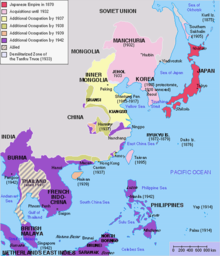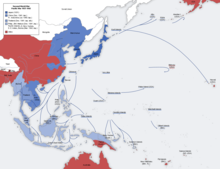Shōwa era
[3] On 7 January 1989, Crown Prince Akihito succeeded to the Chrysanthemum Throne upon the death of his father, Emperor Shōwa, which marked the start of the Heisei era.General Election Law gave all male subjects over the age of 25 the right to vote, provided they had lived in their electoral districts for at least one year and were not homeless.Conservatives forced the passage of the Peace Preservation Law because the party leaders and politicians of the Taishō era had felt that, after World War I, the state was in danger from revolutionary movements.As a result of his failings regarding the London Naval Treaty, Prime Minister Hamaguchi Osachi was shot on November 14, 1930, by an ultranationalist and died in 1931.With the introduction of mass education, conscription, industrialization, centralization, and successful foreign wars, Japanese nationalism began to foment as a powerful force in society.Mass education and conscription served as a means to indoctrinate the coming generation with "the idea of Japan" as a nation state instead of a series of daimyōs.Japanese nationalism was buoyed by a romantic concept of Bushidō and driven by a modern concern for rapid industrial development and strategic dominance in East Asia.It saw the Triple Intervention of 1895 as a threat to Japanese success in East Asia and warned that the "ABCD Powers" (America, Britain, China, and the Dutch), were threatening the Empire of Japan.One of Emperor Shōwa's teachers, historian Kurakichi Shiratori, remarked, "Therefore nothing in the world compares to the divine nature (shinsei) of the imperial house and likewise the majesty of our national polity (kokutai)."[16] The Anti-Comintern Pact brought Nazi ideologues to Japan who attempted but ultimately failed to inject Nazi-style anti-Semitic arguments into mainstream public discussion.In March 1932 the "League of Blood" assassination plot and the chaos surrounding the trial of its conspirators further eroded the rule of democratic law in Shōwa Japan.The nationalists believed that the "ABCD powers" (Americans, British, Chinese, Dutch) were a threat to all Asians and that Asia could only survive by following the Japanese example.Some nationalities and ethnic groups were marginalized, and during rapid military expansion into foreign countries, the Imperial General Headquarters tolerated many atrocities against local populations, such as the experimentations of Unit 731, the sankō sakusen, the use of chemical and biological weapons, and civilian massacres such as those in Nanjing, Singapore and Manila.[19] On July 7, 1937, at the Marco Polo Bridge, the Japanese Kwantung army stationed there used explosions heard on the Chinese side of Manchuria as a pretext for invasion.While the Japanese army possessed a smaller force of armour and artillery than many Western powers, it was far ahead of China in this respect, and was also in command of the world's third largest navy with 2,700 watercraft at its disposal.[20] By 1938, the United States increasingly was committed to supporting China and, with the cooperation of Britain and the Netherlands, threatening to restrict the supply of vital materials to the Japanese war machine, especially oil, steel and money.The main American battle fleet was disabled, and in the next 90 days Japan made remarkable advances including the Dutch East Indies, the Philippines, Malaya and Singapore.After the Imperial General Headquarters refused to remove its troops from China (excluding Manchukuo) and French Indochina, U.S. President Franklin D. Roosevelt announced in July 1941 an oil embargo on Japan.In 1942 the Empire of Japan was at its greatest extent with colonies in Manchuria, China, Indonesia, the Philippines, Malaysia, Papua New Guinea, French Indochina, Burma and many Pacific islands.On August 6, an atomic bomb was dropped on Hiroshima, instantly killing approximately 70,000 people when the attack took place (plus another estimated 130,000 by 1960 due to after-effects).Japan took over French Indochina (Vietnam, Laos and Cambodia), British Malaya (Brunei, Malaysia and Singapore) as well as the Dutch East Indies (Indonesia).On the one hand, it preached the unity of the Greater East Asia Co-Prosperity Sphere, a coalition of Asian nations, directed by Japan, against Western imperialism.Instead, under the Post-war Constitution, the Japanese Emperor was reduced to a figurehead nominal monarch without divine characteristics and is forbidden to play a role in politics.[31] Japan's remarkable economic growth in the decades following 1950 has been called the "Japanese Miracle", as the economy grew three times faster than other major nations.[32] Saburō Ōkita (1914–93), an economist, realized by 1942 that the war was lost; economic recovery that was published in 1945 as "The Fundamental Directions for the Reconstruction of the Japanese Economy".Sugita finds that "the 1950s was a decade during which Japan formulated a unique corporate capitalist system in which government, business, and labor implemented close and intricate cooperation".It coordinated industry and government action and fostered cooperative arrangements, and sponsored research to develop promising exports as well as imports for which substitutes would be sought (especially dyestuffs, iron and steel, and soda ash).Yoshida's successor, Prime Minister Hayato Ikeda, began implementing economic policies which removed much of Japan's anti-monopoly laws.[36] Shimizu argues that the American policy of creating "people of plenty" was a success in Japan and reached its goal of defusing anti-capitalist protest on the left.[40] In the 2020s, there were an increased number of programmes relating to the era, such as Takeda Tetsuya no Shōwa wa kagayaiteita, on the Broadcasting Satellite (BS) television channels.





Emperor HanazonoShōwa (1312–1317)NinmyōJōwa (Heian period)Shōwa (disambiguation)Emperor ShōwaMukden IncidentJapanese invasion of ManchuriaSecond Sino-Japanese WarPacific WarSurrender of JapanConstitutional amendmentEconomic recovery1964 Summer Olympics1972 Winter OlympicsShōwaOccupation of JapanPost-occupation JapanTaishōHeiseiHistory of JapanPaleolithicJōmonFormer Nine Years' WarLater Three-Year WarGenpei WarKamakuraJōkyū WarMongol invasionsGenkō WarKenmu RestorationMuromachiNanboku-chō periodSengoku periodAzuchi–MomoyamaNanban tradeImjin WarBattle of SekigaharaEdo (Tokugawa)Tokugawa shogunateInvasion of RyukyuSiege of OsakaSakokuPerry ExpeditionConvention of KanagawaBakumatsuMeiji RestorationBoshin WarRyūkyū DispositionInvasion of Taiwan (1874)Satsuma RebellionFirst Sino-Japanese WarTreaty of ShimonosekiTriple InterventionInvasion of Taiwan (1895)Colonization of TaiwanBoxer RebellionRusso-Japanese WarTreaty of PortsmouthJapan–Korea TreatyColonization of KoreaWorld War IIntervention in SiberiaGreat Kantō earthquakeMilitarismFinancial crisisNanking incidentInvasion of ManchuriaMay 15 incidentFebruary 26 incidentAnti-Comintern PactTripartite PactWorld War IIAttack on Pearl HarborAtomic bombingsSoviet–Japanese WarPostwar JapanAnpo protestsEconomic miracleAsset price bubbleLost DecadesGreat Hanshin earthquakeCool JapanTōhoku earthquakeImperial transitionCOVID-19 pandemicAbe assassinationNoto earthquakeCurrencyEarthquakesEconomyEra namesEducationEmpireForeign relationsGeographyHistoriographyBuddhismChristianityJudaismShintoMilitaryPoliticsPost-warScience and technologySportsWorld Heritage SitesGlossaryHistoryTimelineJapanese historyhis death on January 7, 1989Taishō eraHeisei eraEmpire of JapanState of Japantotalitarianism, ultranationalism and statisminvasion of ChinaGreat DepressionDefeat in the Pacific Waroccupied by foreign powersend of the emperor's status as a demigodconstitutionalabsolute monarchyparliamentary systemliberal democracy